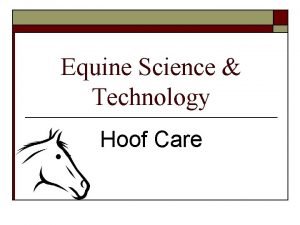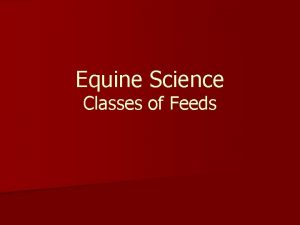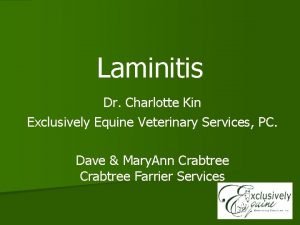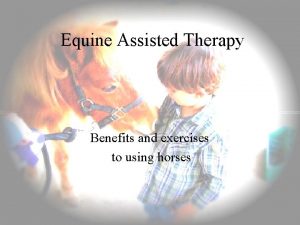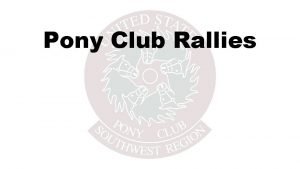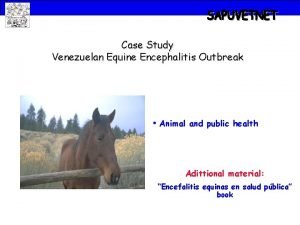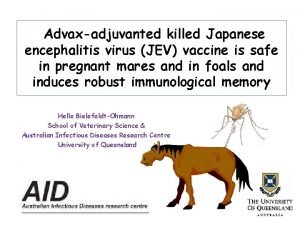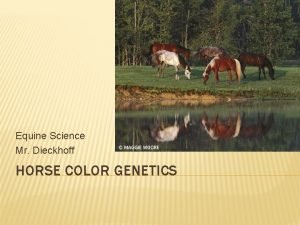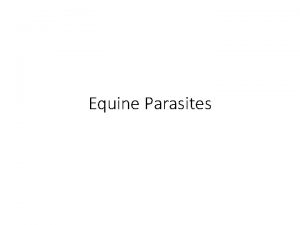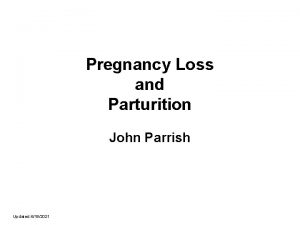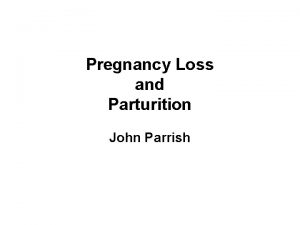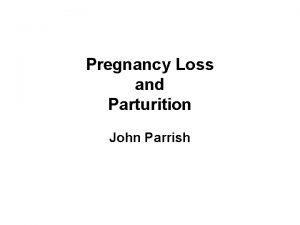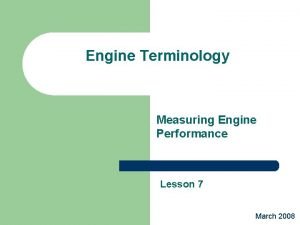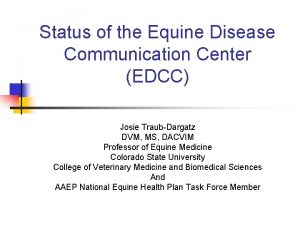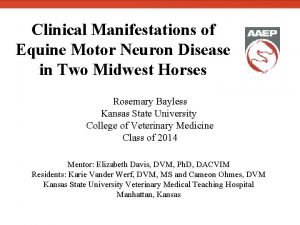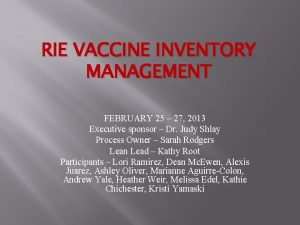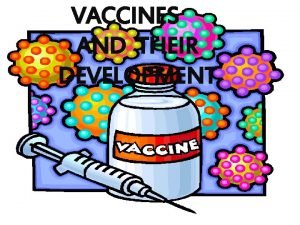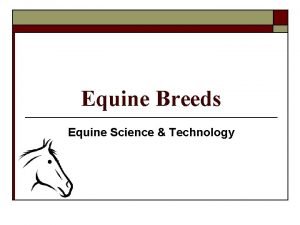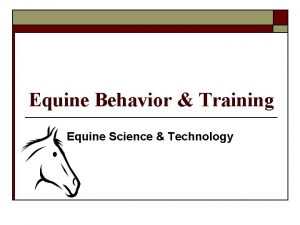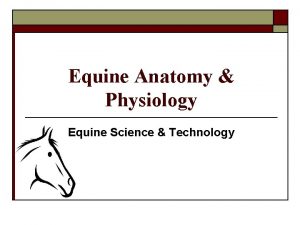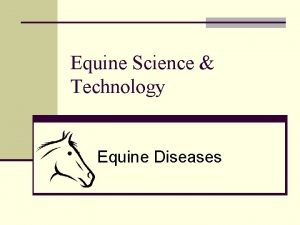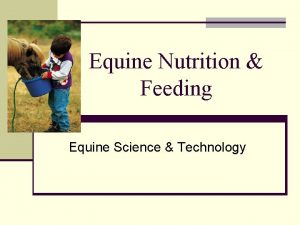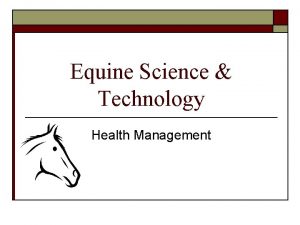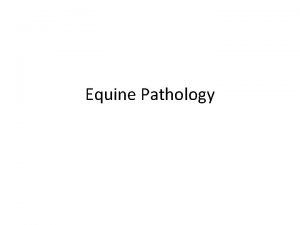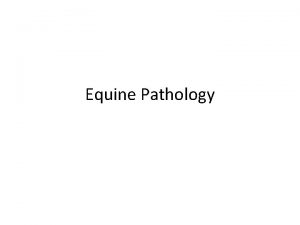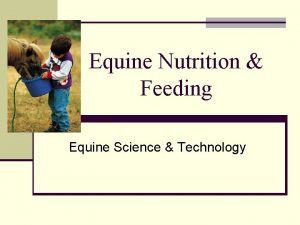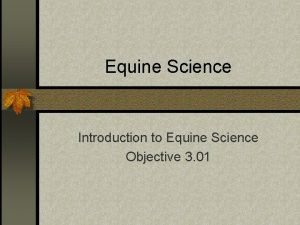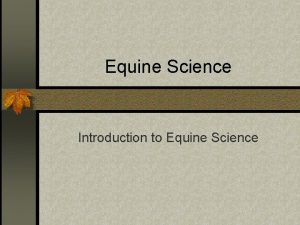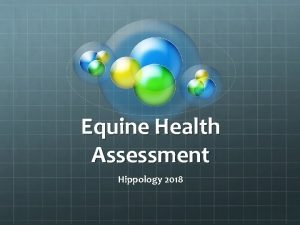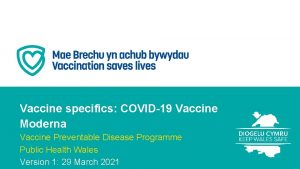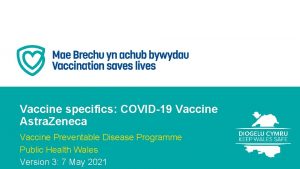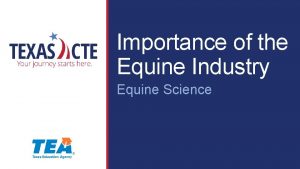Equine Science Technology Health Management Health Management Vaccine






















- Slides: 22

Equine Science & Technology Health Management

Health Management Vaccine- a product given to a horse to stimulate its immune system and help provide protection against disease. There are two types: Killed vaccine- contains killed or inactivated organisms. Modified live vaccine- contains organisms that are live but modified in some way to make them incapable of producing severe disease.

Health Management Vaccination- defined as the administration, by injection or intranasal means, of some agent (such as bacterium or virus) into an animal for the purpose of preventing disease. Ø Ø Cannot depend on vaccination alone for disease prevention. Individual horses vary widely in their response to similar vaccinations.

Health Management Vaccination Ø Heredity also plays a part in the level of resistance. Ø Nutritional management practices also affect degrees of resistance.

Health Management Using teeth to determine age o o The best way to determine the age of the horse is from good records. When a record of age does not exist, the teeth furnish the best estimation of the age of a horse. Age determination is made by a study of the twelve front teeth, called incisors. The two central pairs both above and below are called centrals (centers), pincers, or nippers.

Health Management o o o The four teeth adjacent to these two pairs are called intermediates The outer four teeth are designated as corners. The horse has 24 deciduous (temporary) teeth and 42 adult (permanent) teeth.

Health Management Four key changes in the teeth can be used to estimate the age of horses. Ø Occurrence of permanent teeth Ø Disappearance of cups Ø Angle of incidence Ø Shape of the surface of the teeth

Health Management Occurrence of Permanent Teeth Ø Ø Horses have two sets of teeth, one temporary (baby or milk teeth) and one permanent. Temporary incisors tend to erupt in pairs at eight days, eight weeks, and eight months of age.

Health Management Occurrence of Permanent Teeth Ø Ø Permanent teeth are larger, longer, and darker in color. The four center permanent teeth appear (two above and two below) as the animal approaches three years of age, the intermediates at four, and the corners at five. This constitutes a full mouth.

Health Management Disappearance of Cups Ø Ø Ø Young permanent teeth have deep indentures in the center of their surfaces referred to as cups. Cups are commonly used as reference points in age determination. In general, the cups become smooth in the lower centers, intermediates, corners, upper centers, intermediates, and corners at six, seven, eight, nine, ten, and eleven years of age respectively.

Health Management Disappearance of Cups Ø Ø A smooth mouth theoretically appears at eleven. As cups disappear dental stars appearØ Ø first as narrow, yellow lines in front of the central enamel ring, then as dark circles near the center of the tooth.

Health Management Angle of Incidence Ø The angle of incidence or contact changes from approximately 160 to 180 degrees in young horses, to less than a right angle as the incisors appear to slant forward and outward with aging.

Health Management Shape of the Surface of the teeth Ø Ø Ø The teeth change substantially in shape during wear and aging. The teeth appear broad and flat in young horses. Twenty-year-old teeth may be twice as deep from front to rear as they are wide.

Health Management Obvious signs of dental disease can include: Ø Ø Weight loss Halitosis (bad breath, foul smelling odor from the mouth) Excessive drooling Dropping feed while eating; difficulty chewing

Health Management Subtle signs of dental disease can include: Ø Ø Ø Head tossing Excessive chewing of the bit Behavior problems while being ridden (bucking, fighting against the bit)

Health Management Common Dental Abnormalities Enamel Pointssharp points that develop on the outside of the upper teeth and the inside of the lower teeth as a horse grinds its food back and forth. Ø Removed by using a special file (called a float) to rasp down the sharp edges. Ø Carrying out this process is called floating teeth.

Health Management Common Dental Abnormalities Hooks and Ramps Ø Hooks are sharp points found on the first upper teeth. Ø Ramps are sharp points found on the last lower cheek teeth. Ø A small hook or ramp can be removed by simple filing. Ø A taller point may require cutting with a molar cutter before being filled.

Health Management Retained Caps Ø Ø Ø Deciduous premolars are normally replaced by the permanent premolars without a problem Occasionally a deciduous premolar fails to fall out The retained tooth is called a cap. Retained caps can result in pain for the horse and can lead to decreased feed consumption and lowered performance. The caps can be easily removed by a veterinarian.

Health Management Malalignment Ø Ø If the incisors or cheek teeth of the horse do not align properly, the teeth will not wear evenly. Horses with overshot or undershot jaws will normally need their teeth checked frequently to ensure that the biting and grinding surfaces are meeting.

Health Management Infections Ø Ø Ø Feed that becomes trapped in a tooth can lead to bacterial growth, resulting in infection. Other causes of infection are fractured jaw and inflammation of the periodontal ligament (ligament that holds the tooth to the bone) An infected tooth usually leads to more of the obvious signs of dental disease … Ø Ø Ø Swollen face or jaw A draining abscess Trouble eating, etc.

Health Management Sanitation Ø Ø A sound sanitation program is of paramount importance to fly control. The basic aim of a sanitation program is to reduce or eliminate fly larval development sites. Manure management is essential. Timely spreading of manure promotes drying and prevents larvae from developing.

Health Management Sanitation Ø Ø Wet areas where manure, mud, and plant debris accumulate also form ideal breeding habitats. Modifications to the drainage around corrals to reduce excess moisture can eliminate fly production sites and make chemical control efforts much more successful.
 Equine science
Equine science Equine science
Equine science Sciencefusion think central
Sciencefusion think central Charlotte kin test
Charlotte kin test Lingfield equine vets
Lingfield equine vets Equine definition
Equine definition Us pony club stall card
Us pony club stall card Equine encephalitis
Equine encephalitis Equine encephalitis
Equine encephalitis Pasture pals equine rescue
Pasture pals equine rescue Rhinopneumonitis definition
Rhinopneumonitis definition Equine color calculator
Equine color calculator Strongylus vulgaris
Strongylus vulgaris Parturition
Parturition Equine
Equine Equine
Equine Equine-based unit of engine performance
Equine-based unit of engine performance Equine disease communication center
Equine disease communication center Rto incompass
Rto incompass Equine motor neuron disease
Equine motor neuron disease What is her favourite subject?
What is her favourite subject? Vax trax vaccine management
Vax trax vaccine management Edible vaccine definition
Edible vaccine definition
